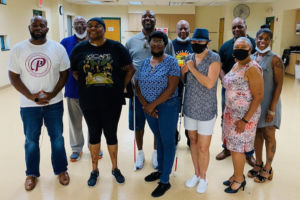In community centers across Mecklenburg, people of all abilities are invited to dance

By GLENNOAKS MEDIA
This article was originally published by QCityMetro on September 29, 2021.
Shemika Robinson was driving home from work one day when all of a sudden her vision went dark.
Terrified, she stopped her Jeep Cherokee in the parking lot of a fast-food restaurant and called her older brother, screaming, “I can’t see! I can’t see!”
Doctors would later reveal that the retinas in both her eyes had suddenly detached, a result of chronic diabetes.
Now 10 year later, Robinson has rebuilt her life as a vision-impaired resident of Mecklenburg County — and that includes learning ballroom dance, thanks to a county-founded program administered by the Arts & Science Council.
The program, Culture Blocks, partners with local individuals and creatives throughout the county to deliver artistic and cultural experiences in neighborhood venues close to where people live.
Robinson, 43, began taking dance lessons in August at the Mallard Creek Recreation Center. The sessions are taught by Purple Charlotte Steppers, which has launched a series of countywide classes called “Watch Me Dance.”
Robinson said the sessions have given her a pipeline to meet new people.
“I like that I can learn some steps,” she said. “I love the way those people be stepping and dancing with partners — the kind of music, the kind of steps. When you go to the classes, you’re inclusive; nobody treats you different because you’re vision-impaired.”
A community partnership
In partnership with Culture Blocks, Purple Charlotte Steppers teaches a variety of dance classes — Detroit Club-Style Ballroom, Chicago-Style Stepping and Soul Line Dancing — on various days of the week and in various community centers. Its Saturday class, taught by a vision-impaired instructor, is designed specifically for people with visual challenges. Some of those students are legally blind.
Robinson said her vision, after numerous operations, is extremely limited.`
“It just depends on how close something is to me,” she said. “I can see some movement when I’m in a car and a car flies by or a big truck or something like that.”
The classes, she said, have given her a new social outlet, a fun reason to leave her house. She gets there each week via a special transportations service provided by CATS.
Robinson said she had never taken a dance class before discovering Purple Charlotte Steppers. Finding viable activities when you’re visually impaired, she said, is not always easy.
“A lot of times I try to reach out to places that I never hear back from, or they find out I’m visually impaired and don’t want to work with me,” she said. “So, for them to have this class as an option is great.”
Bringing dance to Charlotte
Demond Carter, who co-founded Purple Charlotte Steppers, came to Charlotte as a Johnson C. Smith University freshman in 1992. He has lived here ever since.
While growing up in Cleveland, Ohio, he said, he was constantly exposed to adults who made formal dancing a normal part of their lives.
“I thought everywhere you went adults had a dance community,” he said. “We would host cabarets regularly. I remember going to cabarets when I was younger with my mother and father.”
In 2004, when Carter and a friend attempted to host a cabaret at Neighborhood Theatre in NoDa, hardly anyone showed.
“The event was a flop,” he said, recalling who he had flown in people from Cleveland to join what he thought would be a festive event.
“No one in the Charlotte area knew what the stepping culture was or what the urban ballroom culture was,” he added. “So whenever we said ‘stepping,’ people automatically gravitated towards high school drill teams or Greek fraternities. They didn’t think of social dancing.”
Undeterred, Carter later realized that he had “put the cart before the horse.”
“We did the event before people knew how to dance,” he said.
Two years later, in 2006, Carter returned with a class to teach the basics of ballroom dancing. And again, he flew in friends from Ohio, but this time to teach.
“It was packed,” he said. “At least 60 or 70 people showed up for the class. And that’s when I realized that there was a demand.”
Carter eventually sought funding from the Arts & Science Council, proposing to also teach a class for the visually impaired. He teamed up with Keith Robinson, who himself is visually impaired, to lead that class.
Carter said ASC’s support for “Watch Me Dance” has been “huge.”
“We wouldn’t be able to offer as many classes as we do without the Arts and Science Council’s support,” he said.
A social outlet
For Josephine Torres, Glaucoma, a degenerative eye disease, has been stealing her vision for more than 40 years. Now, she said, she is legally blind.
Torres went online and discovered the “Watch Me Dance” sessions, and she has been a regular participant ever since.
“I was born and raised in New York, and I come from a Spanish family,” she said. “Dance has always been around, and I just love music.”
She recalled the last time she danced with her late husband — it was in Puerto Rico, under the stars, moving to the music of a local band.
Like others, Torres said “Watch Me Dance” had become a social outlet, especially during these days of social isolation.
“It means going out, meeting new people, some who are vision-impaired, some who are legally blind, and some are totally blind,” she said. “It’s a form of exercise at the same time.”
Dancing, she said, makes her feel “free.”
“That’s the beauty about dance and music,” she said.
Eboni Lewis, who directs Culture Blocks for ASC, said Culture Blocks is all about providing free activities for people close to their homes.
“This is an opportunity for a family to have a fun outing that maybe they don’t typically get to experience,” she said. “Or perhaps someone realizes they can take what most people call a hobby and transform it into a profession. Those aspects really excite me. It’s a community to create things they love.”

